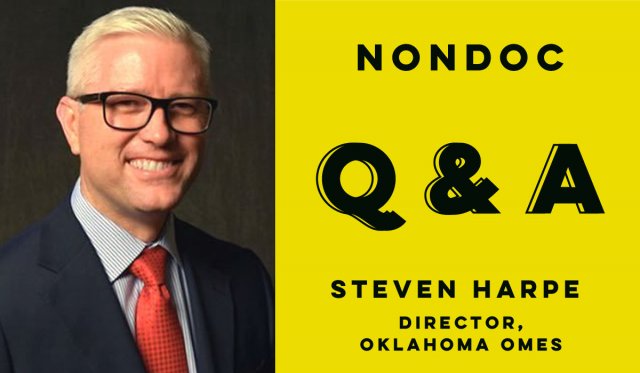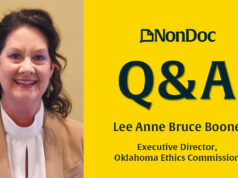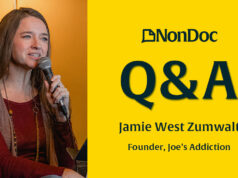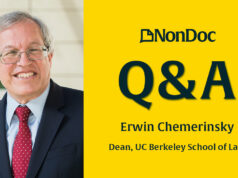Oklahoma Office of Management and Enterprise Services director Steven Harpe has worked in the field of business technology for more than 30 years, but his first foray into government operations could hardly have come at a more interesting time.
While Oklahoma’s numerous state agencies have been slowly testing the water of the technological pool for years, the COVID-19 pandemic has shoved everyone into a deep end that requires work-from-home capabilities and greater public access to state services online.
Harpe conducted an interview with NonDoc on Friday, April 17, to discuss these challenges and his agency’s efforts overall. The following interview has been edited lightly for continuity and length.
There are efforts underway to improve the unemployment benefit process here in Oklahoma, so what is the latest on how that is going?
In terms of what OMES has been involved in, I can tell you it’s been going really well. The call center at OESC has more than 500 agents at any give time and can scale to about 750. That’s a multi-tiered contact point. The web chat stats have been going well in terms of responsiveness.
Around the call center, I can tell you that we went from a time of four-hour waits just to answer the phone and 98 percent call abandonments down to less than 20 second response and .13 percent abandonment now. So we are super proud of those things.
OESC, we rebuilt their website. We did that in about 36 hours. First, we did it on a scalable platform.
There was 2,700 percent increase, which was just crazy volume, but the engine was able to run fine. We didn’t have issues or problems with the website itself. But (Wednesday night) we were able to release changes on the back-end mainframe side, and our state CIO Jerry Moore — who reports to me here at OMES — has been able to work with their technology team to increase sessions (…) so that users are not getting errors near the volume that they were.
So most of the influx of the calls that we were getting were around issues around the technology and the workflow. I feel like a lot of it has been resolved. I think most of what we are dealing with now is follow-up calls and probably policy issues around pandemic unemployment assistance.
Tell us a little about your background, when you joined OMES and how your job has gone so far.
I’ve been with OMES since Sept. 19. I was hired in as deputy director of technology. I was asked to lead technology in the state of Oklahoma. At that time, ISD — or the Information Services Division of OMES — was seen as the “black box” and they were seen as very regulatory. I wanted to enable them and bring enterprise partnerships in. To make a long story short, we also want to build a culture of, when we talk about enablement, it’s not just enablement of the agencies but also enablement within our own teams. We have a lot of talented people in OMES and ISD, and I didn’t feel like we had set them up for success. So since then, fast forward to January and I was promoted to director of OMES and kind of responsible for the whole agency. It’s the same concept. We have four towers, both in ISD and now at OMES, that we do everything through.
It’s the people — it’s (about) investments in our own people. It’s relationships, making sure we have the right relationships with the agencies and the Legislature and the governor’s office. It’s technology, because technology does play a part in everything, and we want to modernize as quickly as we can.
I believe state services should be consumed just like if you walk by Papa John’s pizza. You should be able to use your mobile app, you should be able to get information, you should be able to watch the process, and then you should be able to get that service in a pretty simple and easy way.
The last piece of our strategy was finance, just really getting transparent around our numbers. We wanted to run it like a business. I know some get sick of hearing that, but it’s really needed to make sure we are using our budgets to solve problems, and I’m not sure that has always been the case.
By background, I’ve been a business/technologist professional for 31 years. I’ve worked for some of the largest technology providers on the planet, such as — it was EDS HP — I worked for CGI, I worked for Capital One for a while. And all of those experiences helped me in terms of my decision making of how we could improve what OMES does in order to support agencies. And then I was the CIO of Gateway First Bank for seven years, and that was how I met the governor. I was his CIO. And I’ll just tell you bluntly, the idea was never to come to state government, even after he was elected. But I’m a Rubik’s Cube guy. Once I started hearing about issues and problems and there was an opportunity, I wanted to do it. So I live in Tulsa, and I drive here every day. I’ve been doing this since late September, and I love it. I hate that we are going through this pandemic, but we’ve got some big problems to solve, and I think we are making a lot of progress on that. We just need a little bit more time.
Let’s talk a little bit about those problems that need to be solved. I quoted somebody Thursday saying that this pandemic has exposed some of the issues that we have. Have you seen that on your end?
I think one of the issues that has been exposed is that state government was set up for everybody to have their own kingdoms. Meaning, although we went through a consolidated process, still there are some challenges out there related to those times. So as you start trying to spin up telework capabilities and start trying to spin up people to Office 365 so they can be mobile anywhere and use digital platforms to use [communications mechanisms] it becomes very difficult. ISD under Jerry Moore’s leadership working with multiple agencies has done yeoman’s work to connect everyone so that while we are working from home we can still communicate with each other. But now agencies can actually talk to each other.
I’ll give you an example. Director Justin Brown over at DHS is one of my favorite people. I think he’s a transformative leader. But even DHS for the longest time couldn’t communicate with OMES on some of the communication platforms, and this pandemic exposed that. So we all agreed quickly and collaborated and were able to open up and cross those barriers that were problematic before. Communication systems have been the biggest issue in my mind. Outside of that, we should expect more of ourselves. State government should be consumed just like you would consume any other service in the private sector. One thing I believe, and I’ve said this for a while, is that I don’t judge us against other states. Some states do technology and business process optimization very well, and a lot don’t.
I think we should compare ourselves against the best in a given tower. If the vertical is finance, then we should be comparing ourselves against insurance. Pick the tower. That’s our mission now, and that’s how we are trying to drive change. And for the most part, I think a lot of agencies are willing. There are budgetary constraints and things we need to work through, but because OMES has very good buying power — you know, we have central purchasing as part of our organization — we are able to work through a lot of things to find a solution and get it implemented. But we also have different leadership now. I’ve been a global leader in a couple different areas. Jerry Moore, same kind of pedigree. That’s in the mix with people who have been really strong leaders here, like Dana Webb, who is my chief of staff, Kathy Pendarvis, Shelley Zumwalt obviously is a veteran. We probably have more talent now that has a bigger worldview of how to help us find the problems and help us get those relationships — which are super important — so that people can see that we are here to serve them.
I think the third challenge has been things in this pandemic that have been exposed. Why are we still faxing? Our systems — we are still faxing things and mailing things. We have got to get out of this paper-driven environment and get into digital services and data. Web forms, things of that nature. The state has made some progress, but we’ve got a long way to go in those spaces just to get to a place where people can digitally interface with us with workflow.
There is one last thing I will say, and this is a technology thing as well. We are looking at emerging tech, both with bot technology and [artificial intelligence]. In order not to replace jobs but to build capacity. I mean, in a pandemic like this, wouldn’t it have been great if we had AI in place that was out there able to deal with some of the normal minutia that was coming in so that the more difficult and exceptional processing was being seen by our best and brightest in state government?
I’ve heard some discussions and budget meetings about the memoranda or contracts that OMES has with various state agencies for IT services. The sense I get is there is frustration on both ends of that rope. What can you say about the current situation and where you are trying to take things?
I have no problem answering this one because there is a lot of misinformation on this. We’ve been talking to the Legislature, and they’ve been great partners. I would definitely call out Sen. Roger Thompson (R-Okemah) who has been a great friend and partner of mine since I started my career here as deputy director and now as director of OMES. But the truth is, going into Fiscal Year 2021, the budget we submitted for ISD services was $6.9 million less than last year. The initial submission for the overall budget was about $181 million, and our final budget we submitted was $173 million.
In terms of the rate to agencies, we have 189 agencies and affiliates. That’s the world that ISD lives in. Well, 116 of them — so more than 80 percent of them — were going to get a decrease in technology costs. So that’s a big piece. About 10 percent or so were going to see like a 2 percent increase. Then there was a small percentage — I want to say 9 percent — that was going to see no increase. Then there was an area of 38 agencies that were going to see a fairly significant increase, but those increases were called out that are not technology issues. Those are issues around basically a facility that DPS houses.
So one of my good friends, director Scott Crow over at DOC, they were going to see the largest impact. The number is around the 57 percent range. But that was a facilities issue with a data center that is specific to DPS and has nothing to do with OMES. You take that out, and director Crow would only see a 6 percent increase. But director Crow would also tell you that that agency has struggled mightily with technology, and there is so much makeup that we have been working on. He knows he is going to have to spend a little bit of money to basically ramp his technology.
I’ll tell you this, we created a CIO program at OMES, and I’ve got a guy over there who is now Scott Crow’s CIO that was one of our executives named Sarjoo Shah. Bo Reese, who was the state CIO over at OMES, is now the CIO through this program over at the Department of Transportation. So we are giving them resources and giving them the right people that can actually help fix these problems and design solutions so we can implement on them.
But in terms of budget, OMES and specifically ISD has done a hell of a job getting ready for FY 2021 to make sure there is the least impact as possible. The challenge has been communication, and I think my agency needs to do a better job of communicating this stuff out. And we are doing that.
I feel very good about our rates and our competitiveness and our services going into this budget season.
Tell us something fun or unusual about yourself. What’s something nobody knows about you?
I thought I was going to be a rock drummer as a kid. I started playing in rock bands when I was 15. I’m a drummer. I was actually in a couple bands that did some regional touring. So I’m an old ’80s hair-metal guy. I still play. I love it, I miss it. I say I play, but it’s usually not in front of anybody.
So who is your favorite hair-metal band?
KISS. By far. I’ve seen them seven or eight times.






















